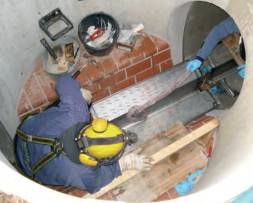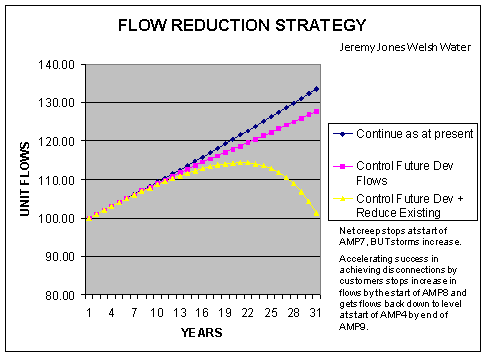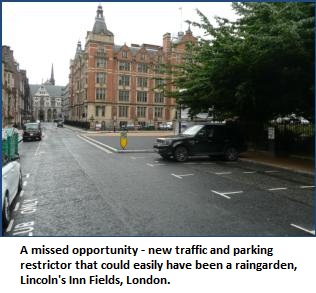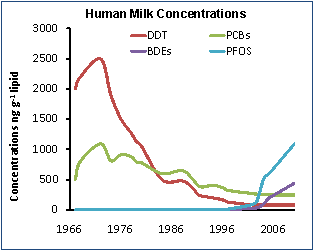Wastewater Forum Archive
WASTEWATER RESEARCH AND INDUSTRY SUPPORT FORUM
Meeting held 15th July 2010
Please note that for older reports some links will be to sites that are no longer active.
This was the Forum’s 41st meeting. It was held in the Boardroom of the Chartered Institution of Water & Environmental Management (CIWEM) in London. Members of CIWEM’s Wastewater Management Panel joined the Forum for the technical presentations and discussion.
Members of the Forum had a very useful exchange of information about urban drainage. A strength of the Forum is that members have a wide range of experience and an initiative or innovation that might seem valuable to some members might trigger concerns about undesirable unintended consequences from others. Green infrastructure (GI) for rainwater in urban areas has been one of the Forum’s recurring themes for several years. Alternative terms such as SUDS or SuDS (sustainable [urban] drainage]) conjure thoughts of particular subsets of GI for some people. To avoid the distraction of semantic distinction we’ll use GI, which is a part of LID (low impact development).
Sewers should have a long life (provided they are properly installed and maintained) so what goes in the ground today should be capable of coping with the extremes that climate change will throw at us. Fortunately the sewerage heroes of the 19th Century such as Eugène Belgrand, Joseph Bazalgette, and William Lindley and his sons built larger sewers than were needed at the time because they recognised that it would be expensive to go back and do it again.
Despite increases in population, sewers built 150 years ago are still core components of our major cities. However many are “combined” sewers, i.e. they carry rainwater as well as sanitary (foul) drainage. 10 mm rain falling on 1000 m2 is 10 m3 water, if it runs off in 10 minutes, the flow-rate is 16.7 litres/sec, but if the runoff were slowed to 60 minutes the flow-rate would be only 2.8 litres/sec. The idea of GI is that some rainwater will not run off at all because it will be absorbed by soil, infiltrate to the groundwater or/and be evapo-transpired from the vegetation and soil. Any water that exceeds the capacity of the GI will run off but over a much longer period of time. Reducing the flow-rate reduces the risk of exceeding the capacity of the underground pipework. The principle of GI is to reduce the run-off at source; the approach in the UK has been to build storage tanks in the sewer network to modulate flow-rate downstream of the tank, because it is all in the ownership of the water and sewerage company and adds to the company’s asset base. New developments in the UK have separate rather than combined drainage; often both are routed into the combined drainage further down the network. Some cities overseas have programmes to separate the old combined drainage but it is expensive and disruptive.
When Thames Water calculated the cost of the Tideway [a 9 m diameter interceptor tunnel that will take all the combined sewer overflows and deliver the flow to a new WwTW downstream of London] it was only ¼ the cost of separating the drainage. The collateral social benefits and costs and the disruption cost were not included in the calculation. Traffic disruption is obvious but there would be disruption to individual properties, for example downspouts at the rear of terraced properties might connect to the combined drainage and be routed through to sewers in the road at the front of properties. On the benefits side, GI reduces the heat island effect in cities [reducing peak temperatures by 5 ºC has been estimated] brings biodiversity and visual enhancement and water that does not enter piped networks does not have to be pumped or treated. The Forum was told that only one discount (inflation) factor is used in the UK water industry business (AMP), which is in contrast to discounted cash flow practised in the 1980s when different factors were used for energy, earnings and general inflation. It might be more appropriate to at least test the sensitivity to energy price increase.
Deciduous plants in GI will not transpire water in winter but GI can still absorb water and modulate the flow-rate of any excess that runs off. Portland, Oregon, which is an exemplar of GI for rainwater, has had success even where soils had near-zero infiltration-rate as well as where soils were free-draining. With time the infiltration rate of poorly draining soils has increased because of the action of plant roots.
London has a particular problem, rising groundwater . Using GI could exacerbate this, however only part of the water going into GI will infiltrate to the groundwater because some will be absorbed, transpired, evaporated, and run off slowly. Companies that used to abstract groundwater in London have moved away or for other reasons stopped abstracting. Consequently, in places, the groundwater table has risen to the depth of the deepest underground train tunnels and basements, etc. Groundwater is being pumped to control the groundwater table; the Forum was told that in most locations it is very clean but it is being discharged to the most convenient location, which is the nearest combined sewer, this seems ironic since Thames Water has just commissioned a desalination plant to cope with future imbalances of demand and supply. Maybe groundwater, like stormwater, should be viewed as a resource that requires the application of ingenuity to exploit it.
Technical presentations
Brian Hickland, International Sales Manager, Uhrig Kanaltechnik GmbH  described the retrofitting of Therm-Liner into sewers so that the wastewater can be used as a renewing source of heat or dump for cooling. He had a sample for members to see. It comprised a cover plate of stainless steel 2 mm thick underneath which were hung the flow and return pipes for transferring energy from/to the wastewater. The surface of the stainless steel is profiled with small ridges to create turbulence that helps to reduce the growth of biofilms, which would reduce heat transfer. The system requirements are a minimum of 800 mm pipe diameter and 10 l/sec flow. If these conditions are met adjacent to a building requiring space heating/cooling the transmission lines are short and losses small. Materials are guaranteed for 50 years and payback in the German market is 10 years or less, whether this included renewable energy subsidies or allowed for energy price inflation was not discussed. Only a relatively short length of Therm-Liner is required (40 m would be typical) and so even though the cross-sectional area of an 800 mm sewer would be reduced by 10% it would not affect the networks capacity significantly; it would merely accelerate the flow through that section.
described the retrofitting of Therm-Liner into sewers so that the wastewater can be used as a renewing source of heat or dump for cooling. He had a sample for members to see. It comprised a cover plate of stainless steel 2 mm thick underneath which were hung the flow and return pipes for transferring energy from/to the wastewater. The surface of the stainless steel is profiled with small ridges to create turbulence that helps to reduce the growth of biofilms, which would reduce heat transfer. The system requirements are a minimum of 800 mm pipe diameter and 10 l/sec flow. If these conditions are met adjacent to a building requiring space heating/cooling the transmission lines are short and losses small. Materials are guaranteed for 50 years and payback in the German market is 10 years or less, whether this included renewable energy subsidies or allowed for energy price inflation was not discussed. Only a relatively short length of Therm-Liner is required (40 m would be typical) and so even though the cross-sectional area of an 800 mm sewer would be reduced by 10% it would not affect the networks capacity significantly; it would merely accelerate the flow through that section.  In heat recovery mode, temperature of the wastewater decreases by approximately 6 ºC across the Therm-Liner but this is immeasurable by the time the wastewater arrives at the WwTW because of wastewater added downstream of the Therm-Liner. Uhrig recommends FOG issues (fat oil and grease) should be sorted out before installing Therm-Liner and that the plates should be cleaned regularly to remove biofilm. There are Therm-Liner projects in Germany, France Austria and Switzerland. Uhrig would like to find partner(s) to establish a first reference site in the UK. After intensive discussion none of the members of the Forum could see a technical problem and it was thought that this use of assets from the ‘regulated’ business would be an issue for Ofwat (the financial regulator).
In heat recovery mode, temperature of the wastewater decreases by approximately 6 ºC across the Therm-Liner but this is immeasurable by the time the wastewater arrives at the WwTW because of wastewater added downstream of the Therm-Liner. Uhrig recommends FOG issues (fat oil and grease) should be sorted out before installing Therm-Liner and that the plates should be cleaned regularly to remove biofilm. There are Therm-Liner projects in Germany, France Austria and Switzerland. Uhrig would like to find partner(s) to establish a first reference site in the UK. After intensive discussion none of the members of the Forum could see a technical problem and it was thought that this use of assets from the ‘regulated’ business would be an issue for Ofwat (the financial regulator).
Dr Tim Evans, Technical Secretary to the Forum described the FWR/WaPUG workshop "Retrofitting green infrastructure for rainwater - what's stopping us?" that was held on 19th April and kindly hosted by the Greater London Authority at City Hall.  There are GI exponents in the UK but it is still far from being the first thing that people would think about. Welsh Water has demonstrated very nicely that merely using GI in new developments will do little to reduce the total flow in sewers and that only by retrofitting will it be possible to return total flow to today’s volume, and that not for 31 years. As President John F. Kennedy is reputed to have been fond of quoting: “The great French Marshall Lyautey once asked his gardener to plant a tree. The gardener objected that the tree was slow growing and would not reach maturity for 100 years. The Marshall replied, 'In that case, there is no time to lose; plant it this afternoon!'”
There are GI exponents in the UK but it is still far from being the first thing that people would think about. Welsh Water has demonstrated very nicely that merely using GI in new developments will do little to reduce the total flow in sewers and that only by retrofitting will it be possible to return total flow to today’s volume, and that not for 31 years. As President John F. Kennedy is reputed to have been fond of quoting: “The great French Marshall Lyautey once asked his gardener to plant a tree. The gardener objected that the tree was slow growing and would not reach maturity for 100 years. The Marshall replied, 'In that case, there is no time to lose; plant it this afternoon!'”
One of the problems is that in the UK we are poor at using interpretive displays to describe what we are doing and why. Without access to information, it should be unsurprising that drainage, etc. are not understood.
Tom Liptan, Portland, Oregon estimates that going from grey engineering to green + grey for the Brooklyn Sewer Basin Upgrade will save $58 million because an $11 million investment in green will reduce grey costs to $75 million compared with an original all grey cost of $144 million.  That is capital before allowing for reduced pumping and treatment costs and for maintenance. The city’s annual rainfall averages 950 mm.
That is capital before allowing for reduced pumping and treatment costs and for maintenance. The city’s annual rainfall averages 950 mm.
The Hamilton Ecoroof (also Portland) was installed in 1999 and monitoring between 2002 and 2010 has shown that it has been prevented 55% of rainfall from entering the city’s drainage sustem by retention, evaporation and transpiration. A cost/benefit
report report found $400k benefit to the building owner and $190k to the public over the 40 year life of the roof. It is out of sight to most people but there’s nothing to prevent an interpretive display at street level to celebrate the building’s achievement.
Factors that inhibit the application of GI are the Civil Engineering courses do not teach GI so graduate engineers only think of grey engineering. Even where GI is considered, clients seldom engage a Soil Scientist or a Landscape Architect to lead the project; and yet the answer lies in the soil and the  planting. Architects design buildings and then engineers engineer them; the equivalent should apply for GI. At least one Surface Water Management Plan in the UK has based its assessment of the applicability of GI on the basis of the drift geology, which is inappropriate because a) geologists only map deposits that are 2 m or more thick and b) GI is more than infiltration. The UK also suffers from a compartmentalisation of responsibilities [fractured institutional organisation] which means that issues such as traffic calming, roads & highways, biodiversity, drainage and wastewater management are not seen from the perspective of benefit to the community and environment but rather to the particular budget-holder’s responsibility.
planting. Architects design buildings and then engineers engineer them; the equivalent should apply for GI. At least one Surface Water Management Plan in the UK has based its assessment of the applicability of GI on the basis of the drift geology, which is inappropriate because a) geologists only map deposits that are 2 m or more thick and b) GI is more than infiltration. The UK also suffers from a compartmentalisation of responsibilities [fractured institutional organisation] which means that issues such as traffic calming, roads & highways, biodiversity, drainage and wastewater management are not seen from the perspective of benefit to the community and environment but rather to the particular budget-holder’s responsibility.
Perhaps the Flood and
Water Management Act (2010) will change the pace of adopting GI for rainwater, but only if there are the skills and if there is awareness. As one participant in the workshop said “The only lack of space [for GI in London] is in people’s heads”.
Prof. Stephen Smith, Imperial College Review of ‘emerging’ organic contaminants in biosolids and assessment of international research priorities for the agricultural use of biosolids. Stephen explained that he has been active in this research area for many years; his first publication was a FWR report in 1994. As a general rule toxic substances are present in soil in trace amounts and the behaviour in soil-water-plant systems falls into three  categories:
categories:
- Rapid volatilisation
- Rapid biodegradation and no persistence
- Strong sorption of persistent compounds by sludge and/or soil
Considering the pathway Sludge – Soil – Plant - Human (i.e. USEPA Pathway 1)
- No bioconcentration in crops is detected (<0.01)
- Negligible uptake = minimal human exposure
The story on POPs (persistent organic pollutants) in human breast milk is mixed: it reflects general environmental exposure (noting to do with biosolids); exposure to DDT and PCBs have decreased because of hazardous substances legislation but exposure to BDE (brominated diethyl ethers – flame retardants) and PFOS (perfluorinated organic substances e.g. Teflon, etc.) have increased.
Prof Smith showed examples of sensationalised publications from poorly designed research into the effects of biosolids that, for example, failed to use proper control treatments or to account properly for the agronomic differences. They misattributed effects to POPs in biosolids merely by association but without any proof. Shamefully some of these publications have found their way through the peer review process.
Prof Smith described how he and Brad Clarke had assessed the risks from a wide range of “substances of emerging concern” regarding the safe land application of biosolids by considering the following in a source-pathway-receptor model:
- What are the likely candidates?
- How much research has been conducted internationally?
- What are the key research priorities to ensure the long-term sustainable management of biosolids?
Their key recommendations were:
- There is a need for long-term vigilance [more research and monitoring, with publication]
- Empirical measurements of the concentrations, fate and impacts
- Some quite high concentration of PCAs (polychlorinated alkanes) have been reported, they are difficult to analyse and perhaps because of this their fate and behaviour have not been studied in detail and their health impacts/risks are therefore uncertain. This is a class of compounds that needs more work.
- Polyfluorochemicals (PFC) have a unique chemistry, they have been classified by the UN as a POP; they too need more work.
In reality the risk of transmission of PCAs and PFCs via land application of biosolids will almost certainly prove to be so low as to be of no concern, but this needs to be demonstrated.
 described the retrofitting of Therm-Liner into sewers so that the wastewater can be used as a renewing source of heat or dump for cooling. He had a sample for members to see. It comprised a cover plate of stainless steel 2 mm thick underneath which were hung the flow and return pipes for transferring energy from/to the wastewater. The surface of the stainless steel is profiled with small ridges to create turbulence that helps to reduce the growth of biofilms, which would reduce heat transfer. The system requirements are a minimum of 800 mm pipe diameter and 10 l/sec flow. If these conditions are met adjacent to a building requiring space heating/cooling the transmission lines are short and losses small. Materials are guaranteed for 50 years and payback in the German market is 10 years or less, whether this included renewable energy subsidies or allowed for energy price inflation was not discussed. Only a relatively short length of Therm-Liner is required (40 m would be typical) and so even though the cross-sectional area of an 800 mm sewer would be reduced by 10% it would not affect the networks capacity significantly; it would merely accelerate the flow through that section.
described the retrofitting of Therm-Liner into sewers so that the wastewater can be used as a renewing source of heat or dump for cooling. He had a sample for members to see. It comprised a cover plate of stainless steel 2 mm thick underneath which were hung the flow and return pipes for transferring energy from/to the wastewater. The surface of the stainless steel is profiled with small ridges to create turbulence that helps to reduce the growth of biofilms, which would reduce heat transfer. The system requirements are a minimum of 800 mm pipe diameter and 10 l/sec flow. If these conditions are met adjacent to a building requiring space heating/cooling the transmission lines are short and losses small. Materials are guaranteed for 50 years and payback in the German market is 10 years or less, whether this included renewable energy subsidies or allowed for energy price inflation was not discussed. Only a relatively short length of Therm-Liner is required (40 m would be typical) and so even though the cross-sectional area of an 800 mm sewer would be reduced by 10% it would not affect the networks capacity significantly; it would merely accelerate the flow through that section.  In heat recovery mode, temperature of the wastewater decreases by approximately 6 ºC across the Therm-Liner but this is immeasurable by the time the wastewater arrives at the WwTW because of wastewater added downstream of the Therm-Liner. Uhrig recommends FOG issues (fat oil and grease) should be sorted out before installing Therm-Liner and that the plates should be cleaned regularly to remove biofilm. There are Therm-Liner projects in Germany, France Austria and Switzerland. Uhrig would like to find partner(s) to establish a first reference site in the UK. After intensive discussion none of the members of the Forum could see a technical problem and it was thought that this use of assets from the ‘regulated’ business would be an issue for Ofwat (the financial regulator).
In heat recovery mode, temperature of the wastewater decreases by approximately 6 ºC across the Therm-Liner but this is immeasurable by the time the wastewater arrives at the WwTW because of wastewater added downstream of the Therm-Liner. Uhrig recommends FOG issues (fat oil and grease) should be sorted out before installing Therm-Liner and that the plates should be cleaned regularly to remove biofilm. There are Therm-Liner projects in Germany, France Austria and Switzerland. Uhrig would like to find partner(s) to establish a first reference site in the UK. After intensive discussion none of the members of the Forum could see a technical problem and it was thought that this use of assets from the ‘regulated’ business would be an issue for Ofwat (the financial regulator). There are GI exponents in the UK but it is still far from being the first thing that people would think about. Welsh Water has demonstrated very nicely that merely using GI in new developments will do little to reduce the total flow in sewers and that only by retrofitting will it be possible to return total flow to today’s volume, and that not for 31 years. As President John F. Kennedy is reputed to have been fond of quoting: “The great French Marshall Lyautey once asked his gardener to plant a tree. The gardener objected that the tree was slow growing and would not reach maturity for 100 years. The Marshall replied, 'In that case, there is no time to lose; plant it this afternoon!'”
There are GI exponents in the UK but it is still far from being the first thing that people would think about. Welsh Water has demonstrated very nicely that merely using GI in new developments will do little to reduce the total flow in sewers and that only by retrofitting will it be possible to return total flow to today’s volume, and that not for 31 years. As President John F. Kennedy is reputed to have been fond of quoting: “The great French Marshall Lyautey once asked his gardener to plant a tree. The gardener objected that the tree was slow growing and would not reach maturity for 100 years. The Marshall replied, 'In that case, there is no time to lose; plant it this afternoon!'” That is capital before allowing for reduced pumping and treatment costs and for maintenance. The city’s annual rainfall averages 950 mm.
That is capital before allowing for reduced pumping and treatment costs and for maintenance. The city’s annual rainfall averages 950 mm. planting. Architects design buildings and then engineers engineer them; the equivalent should apply for GI. At least one Surface Water Management Plan in the UK has based its assessment of the applicability of GI on the basis of the drift geology, which is inappropriate because a) geologists only map deposits that are 2 m or more thick and b) GI is more than infiltration. The UK also suffers from a compartmentalisation of responsibilities [fractured institutional organisation] which means that issues such as traffic calming, roads & highways, biodiversity, drainage and wastewater management are not seen from the perspective of benefit to the community and environment but rather to the particular budget-holder’s responsibility.
planting. Architects design buildings and then engineers engineer them; the equivalent should apply for GI. At least one Surface Water Management Plan in the UK has based its assessment of the applicability of GI on the basis of the drift geology, which is inappropriate because a) geologists only map deposits that are 2 m or more thick and b) GI is more than infiltration. The UK also suffers from a compartmentalisation of responsibilities [fractured institutional organisation] which means that issues such as traffic calming, roads & highways, biodiversity, drainage and wastewater management are not seen from the perspective of benefit to the community and environment but rather to the particular budget-holder’s responsibility. categories:
categories: